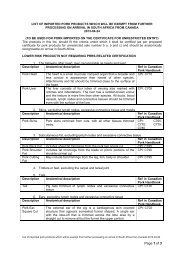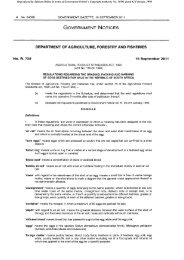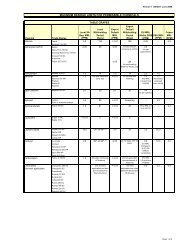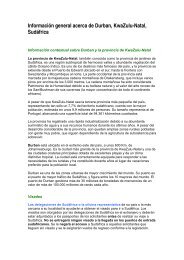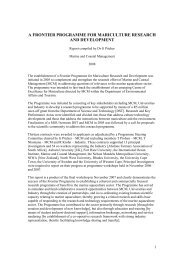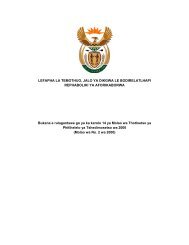Create successful ePaper yourself
Turn your PDF publications into a flip-book with our unique Google optimized e-Paper software.
R<br />
ock lobsters, or spiny lobsters as they are<br />
called in some parts of the world, are<br />
crustaceans. Locally, they are known as crayfish<br />
or ‘kreef’ but they are different from the fresh water<br />
crayfish of Europe and do not have large claws like<br />
the true lobsters. Like their cousins, the crabs, rock<br />
lobsters have hard, external skeletons which are<br />
jointed and allow them to move quickly and<br />
efficiently on their ten jointed legs. Their hard<br />
exoskeleton protects them from predators, but<br />
cannot grow with them. For this reason, rock<br />
lobsters must shed their exoskeleton (moult)<br />
several times as they grow. They are soft and<br />
vulnerable to predators until the new shell hardens.<br />
The rock lobster’s head is the animal’s sensory centre, and<br />
comprises two compound eyes, two pairs of antennae and a<br />
small, fairly sophisticated brain. Five pairs of legs are attached<br />
to the thorax, or central portion of the body, which houses<br />
the reproductive, digestive and excretory organs. The head<br />
and thorax are fused into a single unit called the carapace.<br />
Two species of rock lobster are commonly found close to the<br />
shore in South Africa. These are the West Coast rock lobster,<br />
Jasus lalandii which occurs mainly in the cool waters of the<br />
Atlantic Ocean, and the East Coast rock lobster, Panulirus<br />
homarus which is found in the warmer waters of KwaZulu-<br />
Natal and along the Wild Coast. Two other species of rock<br />
C O A S TA L A N D M A R I N E L I F E – A N I M A L S : I N V E RT E B R A T E S – C R U S T A C E A N S<br />
Rock Lobsters 3B<br />
lobster occur in deeper water, at depths of 100 m or more.<br />
These are Palinurus gilchristi and Palinurus delagoae, both of<br />
which are harvested by commercial fishers. A few colourful<br />
tropical, Indo-Pacific lobsters are found along the coast of<br />
KwaZulu-Natal such as the painted lobster which is blue and<br />
green with white stripes.<br />
Feeding<br />
Rock lobsters are opportunistic<br />
feeders and use their strong<br />
jaws to crush a wide variety<br />
of hard-shelled organisms.<br />
West coast and east coast<br />
rock lobster feed predomi-<br />
nantly on mussels. In regions<br />
where there are insufficient<br />
mussels, rock lobster have been known to feed on sea<br />
urchins, starfish, perlemoen, whelks, periwinkles, crustaceans<br />
and bristleworms. Even seaweed is eaten from time to time.<br />
Life-cycle<br />
The main diet of the west<br />
coast rock lobster is mussels<br />
Rock lobsters have a particularly fascinating life cycle. Females<br />
bear their orange eggs on tiny hairs beneath the tail, and are<br />
said to be ‘in berry’. South African fisheries regulations pre v e n t<br />
fishers from catching rock lobster while they are in berry,<br />
making sure that they have an opportunity to breed.<br />
The eggs hatch after 80-90 days into naupliosoma larvae which<br />
look like transparent spiders. These in turn moult and change<br />
into phyllosoma larvae with long, hairy legs. The phyllosomas<br />
float in ocean currents for over seven months and undergo<br />
11 moults. It is thought that some of them are carried right<br />
around the Atlantic Ocean to South America and<br />
back during this time. The final larval<br />
stage, the puerulus, is a small<br />
colourless lobster, 20 mm<br />
in length. It swims<br />
The rock lobster escapes<br />
by swimming backwards<br />
with a flick of its tail





